Most of the works on this page illustrate the new figure style inaugurated with the reign of Akhenaten. The long faces are characterized by long noses, heavy eyelids, full protruding lips, and elongated chins. The bodies seem deformed with high waists, wide hips, and bulging thighs.
|
Bust of Amenophis IV/Akhenaten
sandstone
Dynasty 18, beginning of his reign--c. 1365-60 BCE
|

|
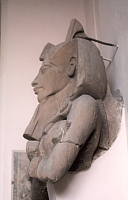
|
This fragment, from the peristyle court at the Temple of Aten at Karnak, was one of 28 pillar statues. These colossal works are similar to traditional Osiride statues but the king is not in the form of a mummy. |
| |
|
Pillar statue from the Temple of Amen-Re, Karnak
sandstone
Dynasty 18, c. 1355-1335 BCE
|
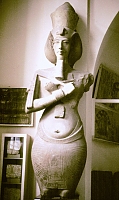
|
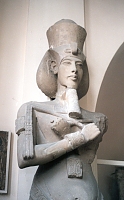
|

|
| |
|
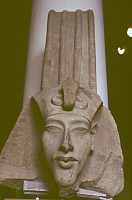
|
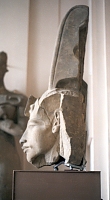
|
Head of Akhenaten |
| |
|
Unfinished head of Nefertiti
brown quartzite
Dynasty 18, c. 1365-1349 BCE
The head would have been part of a composite statue; the various parts would have been assembled after each was finished. |
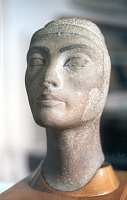
|
| |
|
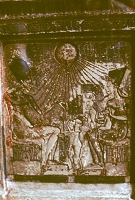
|
Royal Family as Holy Family
painted limestone, from Tell el-Amarna
Dynasty 18, c. 1365-1349
This work was in a private "chapel" in an Amarna house, indicating the role of the king as divine intermediary. Here an intimate moment is depicted with the royal couple and their daughters--Meritaten in the center and the two younger daughters on Nefertiti's lap. The central solar disk, symbolizing Aten, extends rays ending in hands holding ankhs, the symbol for life. |
| |
|
This private shrine, in the shape of a temple facade, was discovered in a private house in Amarna, indicating the existence of a cult based on the royal family. On both sides of the facade the royal family presents offerings under Aten's solar disk. Akhenaten wears the blue crown with streamers at the back and presents a libation to Aten.
|
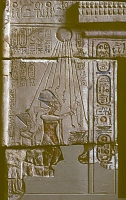
|

|
Shrine (left half)
painted limestone
Dynasty 18, reign of Akhenaten, 1365-1349
|
| |
|
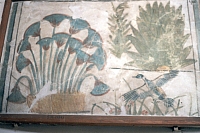
|
Ducks in a Marsh
fresco, painted floor from palace at Tell el-Amarna
Dynasty 18, 1365-1349 |


 Click here to go to the Egypt Index.
Click here to go to the Egypt Index. Click here to return to index of art historical sites.
Click here to return to index of art historical sites.
 Click here to return to index of artists and architects.
Click here to return to index of artists and architects.
 Click here to return to chronological index.
Click here to return to chronological index.
 Click here to see the home page of Bluffton College.
Click here to see the home page of Bluffton College.
